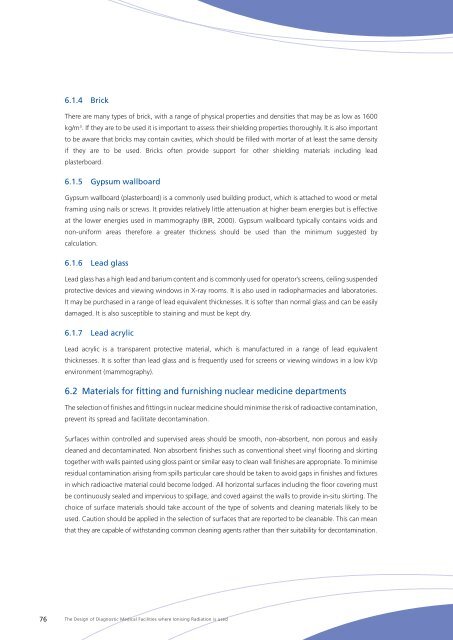The Design of Diagnostic Medical Facilities where ... - ResearchGate
The Design of Diagnostic Medical Facilities where ... - ResearchGate
The Design of Diagnostic Medical Facilities where ... - ResearchGate
Create successful ePaper yourself
Turn your PDF publications into a flip-book with our unique Google optimized e-Paper software.
6.1.4 Brick<br />
<strong>The</strong>re are many types <strong>of</strong> brick, with a range <strong>of</strong> physical properties and densities that may be as low as 1600<br />
kg/m 3 . If they are to be used it is important to assess their shielding properties thoroughly. It is also important<br />
to be aware that bricks may contain cavities, which should be filled with mortar <strong>of</strong> at least the same density<br />
if they are to be used. Bricks <strong>of</strong>ten provide support for other shielding materials including lead<br />
plasterboard.<br />
6.1.5 Gypsum wallboard<br />
Gypsum wallboard (plasterboard) is a commonly used building product, which is attached to wood or metal<br />
framing using nails or screws. It provides relatively little attenuation at higher beam energies but is effective<br />
at the lower energies used in mammography (BIR, 2000). Gypsum wallboard typically contains voids and<br />
non-uniform areas therefore a greater thickness should be used than the minimum suggested by<br />
calculation.<br />
6.1.6 Lead glass<br />
Lead glass has a high lead and barium content and is commonly used for operator’s screens, ceiling suspended<br />
protective devices and viewing windows in X‐ray rooms. It is also used in radiopharmacies and laboratories.<br />
It may be purchased in a range <strong>of</strong> lead equivalent thicknesses. It is s<strong>of</strong>ter than normal glass and can be easily<br />
damaged. It is also susceptible to staining and must be kept dry.<br />
6.1.7 Lead acrylic<br />
Lead acrylic is a transparent protective material, which is manufactured in a range <strong>of</strong> lead equivalent<br />
thicknesses. It is s<strong>of</strong>ter than lead glass and is frequently used for screens or viewing windows in a low kVp<br />
environment (mammography).<br />
6.2 Materials for fitting and furnishing nuclear medicine departments<br />
<strong>The</strong> selection <strong>of</strong> finishes and fittings in nuclear medicine should minimise the risk <strong>of</strong> radioactive contamination,<br />
prevent its spread and facilitate decontamination.<br />
Surfaces within controlled and supervised areas should be smooth, non-absorbent, non porous and easily<br />
cleaned and decontaminated. Non absorbent finishes such as conventional sheet vinyl flooring and skirting<br />
together with walls painted using gloss paint or similar easy to clean wall finishes are appropriate. To minimise<br />
residual contamination arising from spills particular care should be taken to avoid gaps in finishes and fixtures<br />
in which radioactive material could become lodged. All horizontal surfaces including the floor covering must<br />
be continuously sealed and impervious to spillage, and coved against the walls to provide in-situ skirting. <strong>The</strong><br />
choice <strong>of</strong> surface materials should take account <strong>of</strong> the type <strong>of</strong> solvents and cleaning materials likely to be<br />
used. Caution should be applied in the selection <strong>of</strong> surfaces that are reported to be cleanable. This can mean<br />
that they are capable <strong>of</strong> withstanding common cleaning agents rather than their suitability for decontamination.<br />
76<br />
<strong>The</strong> <strong>Design</strong> <strong>of</strong> <strong>Diagnostic</strong> <strong>Medical</strong> <strong>Facilities</strong> <strong>where</strong> Ionising Radiation is used
















